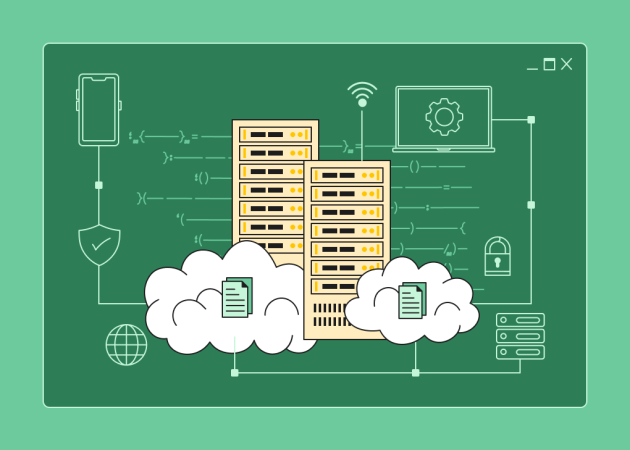
Cloud Architecture Patterns That Support Continuous Delivery
Contents
Contents
Building software is only half the journey. Getting that software to your users quickly, reliably, and safely determines whether your product succeeds in the market. The cloud architecture solutions you choose shape how fast you can deliver features and how confidently you can deploy them. In this article, we’ll explore why certain architectural decisions matter for your delivery pipeline and how to structure your systems to support rapid, reliable deployments.
Why Architecture Patterns Are Critical for Continuous Delivery
Continuous delivery (CD) is a competitive advantage that gets features to market faster. And its success depends on your underlying architecture choices.
“Why is a CD so important? Well, that’s simple. Your developers can write their project and either upload it to the server manually or they can work with a DevOps engineer to create a pipeline that will automatically upload the project to the servers. When you have many servers — for a DevOps platform, a QA platform, a load-testing platform, a stress-testing platform, pre-production, and production — manually uploading everything and editing configuration files for each environment is incredibly difficult,” explains Nadiia Kravchun, Beetroot’s in-house DevOps engineer.
You can approach your architecture choice as a strategic business decision. After all, the cloud patterns you select today will either accelerate or constrain your ability to respond to market opportunities for years to come.

What Is Continuous Delivery and Why Does It Matter for Business Outcomes?
CD is a software engineering practice that lets teams build and release software quickly and reliably. Every code change moves through an automated deployment pipeline that builds, tests, and prepares it for production deployment. This approach, for example, is becoming increasingly important in the development of green technologies where reliable deployments are key to scaling new solutions.
From a business perspective, CD transforms how you compete in the market. Shorter release cycles mean you can test market hypotheses faster. Automated testing reduces the cost and time of manual QA processes. Faster feedback loops help you better understand customer needs. Here’s how CD directly impacts your bottom line:
- Faster Time-to-Delivery. CD reduces the time it takes to get new features and updates to users. By automating the build, test, and deployment phases, teams can release code more frequently and with greater speed.
- Improved Customer Satisfaction. Bugs get fixed faster. Feature requests turn into delivered functionality within weeks instead of months. Your users see that you respond to their needs quickly.
- Reduced Human Error. Manual deployments are prone to mistakes. CD automates the entire process, minimizing the risk of human error and guaranteeing that every release is consistent and reliable.
- Improved Process Control. With CD, the deployment process is standardized and easily monitored. This level of control makes it simple to track what’s being deployed and when.
- Consistent Environments. CD helps maintain uniform configurations across all environments (development, staging, and production). This consistency makes sure that what works in one environment will work smoothly in another one.
- Enhanced Security. A key benefit of CD is improved security. By centralizing access, only the DevOps team needs direct server access. This limits the number of people who can make changes to the production environment.
Nadiia adds, “In a CD pipeline, you can add various types of automated testing. This speeds up how quickly code gets into production and takes some of the workload off your testers.”
All in all, the architecture patterns you choose determine whether these benefits materialize. Some patterns make CD natural and efficient. Others create friction. Understanding this relationship helps you make informed architectural decisions that serve your business goals.
Cloud Architecture Patterns: Key Principles
Evaluating architecture patterns for CD requires a systematic decision framework that prioritizes business outcomes over technical complexity. This framework examines four critical dimensions that determine whether your architecture enables continuous delivery success.
Failure Resilience
You can start by assuming that some part of the system can fail at some point. It can work for months before, let’s say, a deprecated library breaks the entire CD pipeline, and you need a DevOps team to hunt down and resolve the issue. Resilient architectures build recovery mechanisms from day one through redundant components, graceful degradation, and monitoring. That’s why it’s a great move when you evaluate whether your chosen resilience patterns can handle component failures without cascading system-wide outages.
Team Independence
The budget and infrastructure decisions you make determine how independently teams can deploy. You can allocate each team its own platform and then integrate everything centrally, or provide shared platforms across teams. Deployment frequency depends on several factors: how long deployments take, how often teams commit to repositories like GitLab, GitHub, or BitBucket, how many build agents you have available, and whether you use hosted services or self-managed repository solutions.
Rollback Speed and Safety
Your rollback strategy directly impacts deployment confidence. There are several important nuances to that:
“It depends on the architecture and what the team has deployed. If there were changes to the database and migrations started, then a rollback is an expensive operation. If the application’s architecture involved a lot of files, a rollback might replace some files but not others. But if everything is in Docker images and the architecture is stateless, rolling back is pretty easy — you just run the pipeline you need,” clarifies Nadiia Kravchun.
Automated Scaling Capability
Consider whether you need infrastructure scaling or an automatic continuous delivery pipeline and platform provisioning. Everything can be automated if applications and infrastructure follow consistent templates and DevOps teams have sufficient time for automation development and testing.

Core Cloud Design Patterns That Enable Continuous Delivery
Each pattern below delivers specific business value while solving technical CD challenges. We encourage you to explore how these patterns work together rather than implementing them in isolation.
Microservices Architecture
As one of the cloud native design patterns, microservices break your application into independent, deployable services. Each service owns its data, business logic, and deployment lifecycle.
| Business advantage | Technical view | Use case |
| You make fast releases without a negative impact on the entire system. When the checkout service needs updates, you don’t redeploy inventory management or user authentication. | Instead of one large monolithic application, you have many small, specialized services. | You can deploy pricing changes to production three times per day without affecting order processing or customer support systems. |
Event-Driven Architecture
Event-driven architecture allows services to communicate indirectly. When one service completes a task, it publishes an event; other services interested in that event can then act on it without the need to know which service originally sent it.
| Business advantage | Technical view | Use case |
| This approach boosts responsiveness and efficiency, as services react to events in real time and operate asynchronously. | One service sends out a broadcast (“A new user just signed up!”) and any other service that is related to that event can perform an action (e.g., send a welcome email, update a user database). | A ride-sharing app uses an event-driven architecture. When a user requests a ride, this triggers multiple independent services: one to find nearby drivers, another to calculate the fare, and a third to process the payment pre-authorization. |
Immutable Infrastructure
This cloud native design pattern treats infrastructure components like servers as disposable and replaceable. Instead of modifying or updating a running server, you provision a new one from a clean, version-controlled image and replace the old one.
| Business advantage | Technical view | Use case |
| You reduce configuration drift and improve the reliability of deployments. This leads to more predictable environments, fewer production bugs caused by inconsistent server states, and easier disaster recovery. | When you need to update software, you don’t log into the server and run updates. You build a new server image with the updates, deploy new servers from that image, and then terminate the old ones. | You want to apply a critical security patch to its web servers. Instead of patching each live server, the operations team updates a base server image, tests it, and then uses an automation tool to replace the entire fleet of old servers with new, patched ones during a low-traffic window. |
Infrastructure as Code (IaC)
This is one of the cloud native patterns and the practice of managing and provisioning infrastructure (networks, virtual machines, load balancers) through machine-readable definition files.
| Business advantage | Technical view | Use case |
| IaC enables reproducible deployments and faster onboarding. It makes infrastructure provisioning a repeatable, automated process. | Infrastructure becomes testable and versionable. Disaster recovery improves through automated recreation capabilities. | Using Terraform, you can run a single script that automatically provisions all the necessary virtual servers, databases, and networking rules in the cloud. |
Blue-Green Deployment
You can maintain two identical production environments — one serving traffic (blue) while you deploy to the other (green). Switch traffic between them with minimal downtime.
This approach works particularly well in Kubernetes environments. The new release won’t receive traffic until it becomes healthy, so users continue working with the old version during deployment. However, database considerations require careful attention. If new migrations start but applications fail to launch, users access the old application version with the new database structure. This mismatch creates serious problems.
Successful blue-green deployments require meticulous migration planning or master-slave database replication that allows free switching between database states. The database layer often becomes the limiting factor in blue-green deployment strategies.
| Business advantage | Technical view | Use case |
| Safer, near-instant rollbacks. Users experience zero downtime during deployments. You can test new versions under production load before switching traffic. | Complete environment isolation during deployments. Database migration strategies become critical design decisions. Load balancing provides the traffic switching mechanism. | An online banking system switches between blue and green environments for monthly releases, ensuring customers never experience service interruptions. |
Canary Releases
A canary release is a strategy that introduces a new software version to a small group of users before a full rollout.
| Business advantage | Technical view | Use case |
| You can test new features in a live production environment with real users and minimize the risk of a failed release. | Traffic routing controls determine user exposure to new versions. Monitoring and alerting systems detect issues early. Automated rollback triggers respond to quality metrics. | You release new recommendation algorithms to 1% of users, monitor engagement metrics, then gradually expand to 10%, 50%, and finally 100% based on performance data. |
Cloud Native Architecture Tooling That Complements These Patterns
The architectural patterns we’ve discussed don’t exist in a vacuum. They are brought to life by a suite of tools that automate, secure, and monitor the delivery process.CI/CD pipelines are the engine of this process. Tools like GitHub Actions, GitLab CI, or Jenkins automate the steps required to get your code from a developer’s machine into production. They compile the code, run automated tests, and deploy it to your cloud environment. This continuous delivery automation is what makes frequent, small releases possible.
As our expert gets into detail, “The overall approach is the same everywhere; it’s just the syntax of the pipelines that might differ. The concept is you write Linux commands — if the agent is on Linux — to build your code. Or you use ready-made templates, like ‘uses’ in GitHub, for example. You receive an artifact (e.g., a code archive, an image) and upload it to the platform. You can work with the code internally to get an artifact from it in multiple ways. You might do a gcc build for C++, Maven for Java, or just copy files and install the necessary libraries for Python. The DevOps engineer should receive all these directives from the developers who wrote the code.”
To make these automated releases safer, you can rely on several key tools:
- API Gateways. An API gateway is a single point of entry that handles all incoming client requests. This is invaluable for deployment strategies like canary releases or blue-green deployments.
- Feature Flags (or Toggles). These tools allow you to turn specific features on or off for certain users without deploying new code. This decouples code deployment from feature release. You can push code for a new feature to production, but keep it hidden behind a flag.
- Observability Tools. How do you know if a new release is successful? Observability tools (covering metrics, logs, and traces) give you the answer. Platforms like Datadog, New Relic, or Prometheus provide deep insight into your application’s performance and health.
These tools work in tandem with your cloud architecture to create a system of continuous delivery elements that enable you to release features quickly.

Making the Right Architecture Choices for Your Delivery Goals
There is no single “best” cloud architecture. Every pattern, from a simple monolith on virtual machines to a complex serverless microservices setup, comes with its own set of trade-offs. The right choice for your organization depends entirely on your specific context and goals.
Before you commit to an architectural pattern, you can consider these factors:
- Business Stage. Are you a startup trying to find product-market fit? A monolithic architecture might allow you to move faster and iterate with a small team. Are you a scaling enterprise with multiple development teams? A microservices architecture could help you decouple teams and let them release independently.
- Compliance and Risk. Do you operate in a highly regulated industry like finance or healthcare? Your architecture must accommodate strict security and compliance controls. Patterns that offer greater isolation and finer-grained control, though more complex, might be necessary.
- Team Capacity and Skills. Does your team have deep experience with Kubernetes and distributed systems? If not, adopting a complex microservices architecture could slow you down.
- Future Roadmap. Where do you see your product in two years? Five years? While you shouldn’t over-engineer for a future that may never arrive, your architecture should be able to evolve. Choose a pattern that solves today’s problems but doesn’t close the door on tomorrow’s needs.
The real value emerges when you find the right balance between delivery speed and operational stability. Pushing features out quickly is pointless if your system is constantly breaking. Conversely, a perfectly stable system that never changes is a liability. Your cloud architecture is the framework that helps you strike this crucial balance.
Conclusion: The Architecture Behind Faster, Safer Delivery
Your cloud architecture is the blueprint for fast, safe delivery. The right patterns create a resilient and scalable pipeline, turning frequent, low-risk releases from a lofty goal into your daily reality. This is how you innovate faster, respond effectively to market feedback, and build a product your users can rely on.
Beetroot can help you design and implement cloud architecture solutions that align with your specific delivery strategy and business needs. We also provide comprehensive DevOps services for accelerated deployment cycles.
Want to build a foundation for faster, safer releases? Let’s get in touch.
FAQs
What is the best cloud architecture pattern for continuous delivery?
There’s no universal best pattern. Before making the final commitments, you can consider your team size, project complexity, and existing infrastructure. You need to select patterns that align with your deployment frequency and risk tolerance.
How does cloud architecture impact software delivery speed?
Project size often has more impact on delivery speed than architectural patterns. A simple monolithic landing page deploys faster than a complex microservices system. The build time matters more than the architecture type — focus on optimizing your specific bottlenecks rather than following trends.
What are the key benefits of microservices for continuous delivery?
Microservices enhance CD by enabling the independent deployment of small, single-function services. This empowers teams to release new features and updates more frequently and with less risk. It simplifies the pipeline, reduces build times, and makes it easier to manage and scale the application.
Why is Infrastructure as Code important for continuous delivery?
IaC is crucial for continuous delivery because it enables businesses to streamline the provisioning and management of their infrastructure. This guarantees that the continuous delivery environment is consistent, reproducible, and easily version-controlled, which are essential for reliable and rapid deployments.
Can traditional monolithic apps support continuous delivery in the cloud?
Yes, traditional monolithic applications can support continuous delivery in the cloud. While microservices are often associated with the concept, a well-managed monolithic application can still be deployed continuously using proper automation, a streamlined build process, and an effective cloud-based deployment pipeline. The key is to have the right continuous delivery tools and practices in place to automate the build, test, and deploy stages.
Subscribe to blog updates
Get the best new articles in your inbox. Get the lastest content first.
Recent articles from our magazine
Contact Us
Find out how we can help extend your tech team for sustainable growth.






